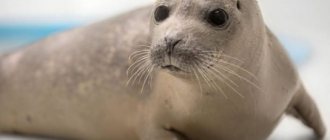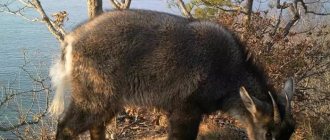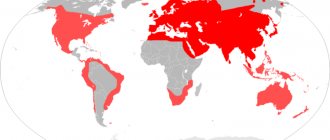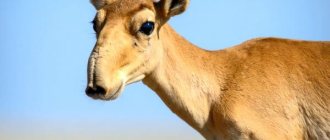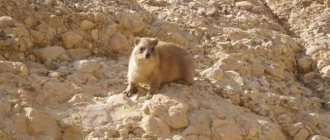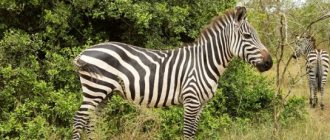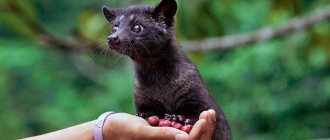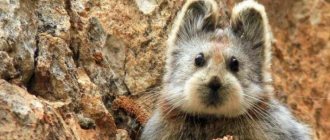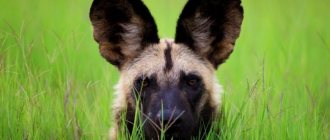- Wild animals
- >>
- Mammals
The sea lion is the largest member of the family Otariidae, the “eared seals,” which includes all sea lions and fur seals. It is the only representative of the genus Eumetopias. Eared seals are distinguished from clams, the "true seals", by having external ear valves, long flipper-like forearms used for propulsion, and rotating rear flippers that enable quadrupedal locomotion on land.
Origin of the species and description
Photo: Sivuch
Steller sea lions, or eared seals, are one of the three main groups of mammals in the taxonomic group Pinnipeds. Pinnipeds are aquatic (mostly marine) mammals that are characterized by having both forelimbs and hindlimbs in the form of fins. In addition to sea lions, other pinnipeds include walruses and fur seals
Steller sea lions are one of two groups of seals (any pinniped except walruses): the earless seals, which include the taxonomic family of true seals (Phocidae), and the eared seals, which include the family of eared seals (Otariidae). Walruses are usually considered a separate family of pinnipeds, Obobenidae, although they are sometimes included in the mollusc family.
Video: Sea lion
One way to differentiate between the two main groups of seals is by the presence of the pinna, a small, furry ear flap (outer ear) found in sea lions and absent in true seals. True seals are called "earless seals" because their ears are difficult to see, while sea lions are called "eared seals." The name "otariid" comes from the Greek "otarion" meaning "small ear", referring to the small but visible outer ears (pinna).
In addition to the presence of an auricle, there are other obvious differences between sea lions and true seals. Steller sea lions have rear fins that can be turned forward under the body, aiding their movement on the ground, while the rear fins of true seals cannot be turned forward under the body, causing them to move slowly and awkwardly on the ground.
Steller sea lions also swim using their long front flippers to propel themselves through the water, while true seals swim using their back flippers and lower body in a side-to-side motion. There are also behavioral differences, including in the breeding system.
Appearance and features
Photo: What a sea lion looks like
The lustrous-coated sea lion is called the "sea lion" due to the light mane of coarse hair found on the male's neck and chest, reminiscent of a lion's mane. It is sometimes mistaken for a seal, but the difference is easy to spot. Unlike seals, the sea lion's external pinnae cover their ears to protect them from water. Steller sea lions also have a bony structure that allows them to walk on all their fins, supporting their entire weight.
Fun fact: As the world's largest sea lion, an adult sea lion can reach a length of two to three meters. Females weigh between 200 and 300 kilograms, while males have been found to reach up to 800 kilograms. One massive sea lion weighed almost one ton.
The average sea lion pup weighs about 20 kilograms at birth. At birth, sea lion puppies have thick, coarse, almost black fur with a frosty appearance because the ends of the hair are colorless. The color lightens after the first moult in late summer. Most adult females are colored on the back. Almost all males remain darker on the front of the neck and chest, some even reddish in color. Adult males have prominent broad foreheads and muscular necks.
Interesting fact: Steller sea lions swim in water using breaststroke and can reach a maximum speed of about 27 km/h.
The sound of sea lions is a chorus of low-frequency "roars" from older individuals mixed with the "lamb" vocalizations of young pups. California sea lions can often be heard among the sea lions in southeast Alaska, their "barking" sounds being a distinctive clue for finding these smaller, darker sea lions.
Human interaction
Sea lions practically do not get used to captivity; they are wary and even hostile towards people. But there are three unique cities in the world where pinnipeds coexist peacefully with people. One of them is American Seattle. The other two are Sakhalin-Nevelsk and Petropavlovsk-Kamchatsky, located in the Russian Far East.
In Nevelsk, after the earthquake, tourists can approach the colony only by boats and boats, in Petropavlovsk-Kamchatsky at the fish factory pier - from the water and from the shore.
Volunteers carry out educational work for tourists. Information boards with a description of the species have been installed. You can see sea lions not in a zoo, but in natural conditions.
The culture of non-intervention will never take root in Russia. Despite the hanging signs prohibiting feeding the animals, every second traveler tries to treat them with fish. People approach the colony to take photos, disturbing the silence of the timid sea lions.
Where does the sea lion live?
Photo: Kamchatka sea lion
Steller sea lions prefer the colder temperate climate to the subarctic waters of the North Pacific Ocean. They require both terrestrial and aquatic habitats. They mate and give birth on land, in traditional places called rookeries. Rookeries typically consist of beaches (gravel, rock or sand), ledges and rocky reefs. In the Bering and Okhotsk seas, sea lions can also pull up sea ice. In the North Pacific, sea lion habitat can be found along the coast of California to the Bering Strait, as well as along the coasts of Asia and Japan.
The world population is divided into two groups:
- eastern;
- Western.
Steller sea lions are distributed primarily along the North Pacific coast from northern Hokkaido, Japan through the Kuril Islands and the Sea of Okhotsk, the Aleutian Islands and the Bering Sea, the southern coast of Alaska and south to central California. Although they are most often found in coastal waters on the continental shelf, they also occasionally forage on much deeper continental slopes and in pelagic waters, especially during the non-breeding season.
Canadian residents are part of the eastern population. In Canada, the offshore islands of British Columbia have three major breeding areas for sea lions, located on the Scott Islands, Cape St. James, and offshore the Banks Islands. In 2002, approximately 3,400 puppies were born in British Columbia. During the breeding season, the total population of animals found in these coastal waters is approximately 19,000, with approximately 7,600 of these being of breeding age. This is the most powerful breed of males with several females.
Sea lions breed along the North Pacific Ocean from Año Nuevo Island in central California to the Kuril Islands north of Japan, with the largest concentration of rookeries in the Gulf of Alaska and the Aleutian Islands.
Now you know where sea lions are found. Let's see what this seal eats.
Sea lion: description, structure, characteristics. What does a sea lion look like?
You can get to know sea lions better only in the summer, when they spend a lot of time on land. Having parted with their element - the sea, hundreds of animals come ashore and settle in the so-called rookeries. Walking on the ground with the help of flippers is not very convenient for them. However, sometimes sea lions can even run, as they say, as fast as they can - if they notice that one of the inhabitants of their harem is about to move to a neighbor. (I thought that a formidable sea lion, also known as a sea lion, could become a good trademark of some company. Imagine how unusual, say, a self-adhesive label or an advertising poster would look with it).
This beast has another amazing ability. He can jump from steep cliffs into the sea with extraordinary ease, according to all the rules of sportsmanship. Anyone who sees a sea lion climbing rocks for the first time also does not immediately recover from amazement. Massive animals (the weight of some males - cleavers - reaches 1300 kilograms, length - 4 meters, and they have a girth of up to 3 meters) can get through places where a person cannot get through without special equipment. They succeed in this thanks to their ability to skillfully shift the center of gravity. To imagine how they move, you need to remember how a snail crawls, “shimmering.” When moving, the sea lion's fins are very helpful: it places the main emphasis on them, in addition, the grooves on the fins are well developed, and the grip on rocks is excellent.
Steller sea lions were “discovered” a little over two hundred years ago, but it cannot be said that they were spoiled by the attention of zoologists. There are still ambiguities in the biology of this animal, and knowledge about the behavior of sea lions was not very extensive. The structure of populations was poorly studied, almost nothing was known about the methods of communication in these animals.
Tatyana Yurievna Lisitsyna, an employee of the Severtsov Institute of Evolutionary Morphology and Animal Ecology, made her first observations of the behavior of sea lions and a magnetic recording of their sound signals on the Commander Islands, then on Kamchatka, on Cape Shipunsky, and now a hunting schooner, cutting the waves of the Sea of Okhotsk, was approaching the island of Jonah. A mountain was clearly visible in the blue sky. Its peak rose 165 meters above sea level. The island was gloomy. Its slopes fell into the sea with almost vertical cliffs. Approaching Jonah was not an easy task. Among the hundreds of stones that surrounded him, the breakers were always beating against the shore. They bravely guard the island and its underwater rocks. In addition, there was a big wave, a force four storm, and a strong swell. At the opposite end of the island it turned out to be smaller, but we still had to get to the island by boat.
T. Yu. Lisitsyna and her assistant, MSU student S. Kharitonov, had to live on Iona for two months.
FROM THE DIARY
"We were lucky. The house that meteorologists erected has still been preserved. This is the only flat place on the island. All night (fortunately it was light) they carried provisions and equipment up from the cliff. The house stands at an altitude of 50 meters above sea level. The climb is steep: in one place there is a rope, in another - on stones. You walk and don’t know which one to step on: a bird sits everywhere and looks with an anxious eye. You can touch any one, and it won’t leave—it’s the height of incubation. They sit tightly, within pecking distance. If you come in from the front, everyone has white shirtfronts; if you come in from the back, everyone is in black tailcoats.”
There has always been a sea lion on Iona. Somewhere he was knocked out, somewhere he came back a year later. Since time immemorial, animals have been swimming here from summer to summer. Here they form harems, here the cubs are born. Cleavers are the first to arrive on the island. They immediately begin to settle along the shore. Everyone tries to grab a better plot for themselves and defends it in fights.
The spatial structure of any population is formed in the process of evolution and reflects the ways of the most complete and “rational” use by animals of the entire complex of external conditions with the same full realization of their internal capabilities. Therefore, a certain type of spatial structure represents a kind of ecological adaptation to specific conditions. This means that it is a weapon in the species’ struggle for a place in the Sun.
What does sea lion eat?
Photo: Sea Steller
Steller sea lions are carnivores with sharp teeth and strong jaws that eat their prey. They catch their own fish and eat what is most available in their area. In British Columbia, sea lions eat mainly schooling fish such as herring, hake, salmon and sardines. Sometimes they dive deeper to catch sea bass, flounder, squid and octopus.
Fun fact: Steller sea lions are excellent swimmers, sometimes diving to depths of over 350 meters in search of food and usually staying submerged for no more than five minutes at a time.
Adult sea lions feed on a variety of fish, including Pacific herring, sand lance, Atka mackerel, pollock, salmon, cod and stonefish. They also eat octopus and some squid. On average, an adult sea lion requires about 6% of their body weight per day. Young sea lions require twice as much food.
Steller sea lions also kill fur seals and other animals. On the Pribilof Islands, young male sea lions have been observed killing and eating northern fur seal pups, while elsewhere they have occasionally eaten ringed seals. Through their diet, sea lions can influence populations of fish, bivalves, gastropods and cephalopods.
Features of character and lifestyle
Photo: Sea lion in nature
Steller sea lions are mammals, so they need to come to the surface to breathe air. They spend part of their time on land and go out into the water to hunt for food. Steller sea lions prefer the coastal shelf area within 45 km of the coast, although they can be found more than 100 km from the coast in waters more than 2000 m deep. They do not migrate like some seals, but move seasonally to different feeding and resting areas.
Steller sea lions are usually sociable and are found in large groups on beaches or in rookeries. They usually live in groups of two to twelve, but sometimes up to one hundred individuals are found together. At sea they are solitary or move in small groups. They forage at night off the coast and in pelagic waters. Steller sea lions can travel long distances during the season and can dive to depths of up to 400 m. They use the ground as places to rest, moult, mate and give birth. Steller sea lions produce powerful vocalizations, which in males are accompanied by vertical shaking of the head.
Sea lion breeding is one of nature's most popular spectacles. When these giants crash onto the shore, their favorite beaches, called rookeries, disappear under their bodies. Young puppies are sometimes overwhelmed by the crowd and are not listened to by powerful males with a single purpose. Males must establish and maintain a rookery territory in order to reproduce. Most of them don't do this until they are nine or ten years old.
Lifestyle
The annual cycle of sea lions is divided into two distinct periods: nomadic and rookery. During the nomadic period, animals make short migrations and come ashore only to rest. The rookery reproductive period begins in early spring.
The first to appear on the rookeries are male loppers. A cleaver is a sexually mature male, 7-8 years old, capable of occupying territory in a harem area. Having divided the territory into sections, future harems, the males begin to protect them. At this time, their behavior is demonstratively aggressive, the loppers walk around their areas, periodically growling demonstratively at their neighbors.
After this, in the second half of May-early June, females begin to arrive. The harems of sea lions are small: with one male there are rarely more than 12 females. Arriving females in the first days give birth to cubs, which they have carried for a year since the previous reproductive period, and within a few days they mate again.
In addition to harem (reproductive) haulouts, so-called bachelor haulouts are also formed. Young sea lions are located on them, as well as young males - cleavers, who were unable to occupy a site in the reproductive territory, and old cleavers, no longer capable of reproducing. After the end of the breeding season, many animals move and the division into bachelor paddocks and harems is no longer relevant.
Usually the female gives birth to one large calf, the body length of which is almost half the length of the mother’s body and is 100-120 cm, and the weight reaches 17-20 kg. During the year, sea lions feed on their mother's milk, although at the end of this period other food is also found in their stomachs. At this time, they grow very quickly, the average length of a one-year-old sea lion from the waters of Alaska is 175 cm. Babies are born sighted and soon begin to crawl quickly over stones, quite deftly dodging adult animals that can accidentally crush them.
Social structure and reproduction
Photo: Steller sea lion in the water
Sea lions are colonial breeders. They have a polygynous mating system in which only a small proportion of mature males father the majority of the pups at certain times of the year.
The mating season for sea lions is from late May to early July. At this time, the female returns to her home rookery - an isolated rock where adults gather to mate and give birth - to give birth to one pup. During mating season, sea lions gather in dense colonies for safety, away from land-based predators. The sounds of adults and the bleating of newborn puppies create a loud protective noise. This collective and constant noise discourages possible predators.
A female sea lion cares for her pup for one to three years. The mother stays on land with her pups for one day and then goes to sea to collect food for the next day. She follows this pattern to feed her puppies while continuing to maintain her own nutrition.
A newborn sea lion is an agile little creature. He can crawl from birth and learns to swim at about four weeks of age. Although it is quite difficult to estimate, it appears that the mortality rate for pups is quite high and may be the result of older animals being displaced or in cases where they are forced to leave the rookery they find themselves unable to swim and drown.
Puppies develop immunity to most diseases while they are breastfed. As puppies mature and are weaned, they may become ill due to internal parasites (such as roundworms and tapeworms) that affect growth and lifespan. The female sea lion is acutely aware of her pup's needs, never leaving it for more than a day at a time during the critical first month of its life.
Security
Increasing the species' numbers has proven to be a difficult task. These animals cannot be crossed with other lions. Indeed, in this case, genetic purity will be violated.
The authorities of the state in which the Girsky reserve is located do not transfer these animals to other reserves or parks. Since the species is unique, the state supports the reserve and provides financial support. When Indian lions begin to breed in other areas, the support program will be reduced. Today the number of individuals, although slowly, is growing. Therefore, it is assumed that some of the animals will eventually move outside the reserve.
In Indian culture, unity with nature is of great importance. Therefore, people do not destroy lions for profit or fun.
Natural enemies of sea lions
Photo: Steller sea lion
Over the years, human activities such as hunting and killing have posed the greatest threat to sea lions. Luckily, these are also the most preventable risks. This large creature is also susceptible to accidental entanglement in fishing gear and can be strangled by debris around their necks. An entangled sea lion can potentially drown before it can escape or free itself.
Pollution, oil spills, and environmental contaminants such as heavy metals threaten sea lion habitats. This preventable harm can lead to the displacement of residents from their vital habitats and ultimately their population decline.
Steller sea lions also face natural threats, such as a decrease in the amount of food available. In addition, they are hunted by killer whales. As with all animals, the disease poses a potential risk to the sea lion population.
Scientists are currently investigating why sea lion populations are declining. Possible reasons for this include increases in parasites, disease, killer whale predation, food quality and distribution, environmental factors, and nutrient deficiencies caused by natural changes in the abundance of major prey species or competition with other species or humans for food.
Population and species status
Photo: What a sea lion looks like
The two populations of sea lions represent different genetic, morphological, ecological and population trends. Population trends between eastern and western populations differ for complex reasons. Simply put, the difference is likely a result of the different types and magnitudes of threats faced by the species throughout its range.
The western population includes all sea lions originating from the rookeries west of Suckling Point. The sea lion population has declined from approximately 220,000 to 265,000 animals in the late 1970s to less than 50,000 in 2000. While the western population as a whole has grown slowly since about 2003, it is still declining rapidly in large areas of its range.
The eastern population includes sea lions originating from rookeries east of Suckling Point. Between 1989 and 2015, their numbers in the east increased at a rate of 4.76% per year, based on an analysis of pup populations in California, Oregon, British Columbia and southeast Alaska. More than 80% of the sea lion population disappeared from Russia and most Alaskan waters (Gulf of Alaska and Bering Sea) from 1980 to 2000, leaving fewer than 55,000 individuals remaining. Steller sea lions are listed in the Red Book as those that are in danger of extinction in the near future. Threats to sea lions include:
- impacts from a boat or ship;
- pollution;
- habitat degradation;
- illegal hunting or shooting;
- offshore oil and gas exploration;
- interaction (direct and indirect) with fisheries.
Direct impacts on the fishery are largely due to fishing gear (drift and gillnets, longlines, trawls, etc.), which can entangle, snag, injure or kill sea lions. They were seen entangled in fishing equipment, which is considered "serious injuries." Indirect impacts of fishing include the need to compete for food resources and possible modifications of critical habitat as a result of fishing activities.
Historically, threats have included:
- hunting for their meat, hides, oil and various other products (in the 1800s);
- murder for reward (early 1900s);
- killing in order to limit their predation on fish in aquaculture establishments (fish farms). But the deliberate killing of sea lions was not permitted as they were protected under the Marine Mammal Protection Act.
Khabarovsk region
Status: 2nd category. Vulnerable, declining species.
Spreading
In the region they are found in the center of the Sea of Okhotsk near Iona Island and the Shantar Islands, where they form summer aggregations. Of the eared seals it has
has the widest range and is found along the perimeter of the subarctic region of the Northern Pacific. The modern range covers the Sea of Okhotsk and the Bering Sea, in the north it extends beyond their borders into the Chukchi Sea, and in the south into the Sea of Japan. In many areas the distribution is seasonal. In the north of the Japanese Islands and the Korean Peninsula, sea lions are observed only in the winter months. They are not found off the coast of the northwestern part of the Sea of Okhotsk and the northern coast of Shelikhov Bay, although the possibility of finding single individuals cannot be ruled out.
Number
Unknown for the coast of the region.
Source: Red Book of Khabarovsk Territory. EAT. Nikitina, M.V. Salnikova (2008) Ed. house "Priamurskie Vedomosti"

